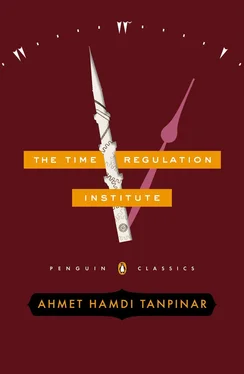But Tanpınar did not respond to this feckless program of Westernization with a conservative or backward-looking project like Dostoyevsky’s pan-Slavism. Tanpınar hoped for a synthesis of past and present that went beyond secularist slogans and state programs for modernization. In opposition to a parochial nationalism, Tanpınar invoked the cosmopolitanism of Istanbul — something that has become a tourist-brochure cliché in our own time but wasn’t so obvious in the 1930s, when the city was disdained by secular Kemalists for its centrality to the superseded Ottoman Empire. The old city brought the traditional together with the modern, the foreign with domestic, and the “beautiful with ugly”—an intermingling originally forged by “the institutions of Islam and the Ottoman Empire.” And it was important to emphasize this because, Tanpınar wrote, echoing many writers in Japan and other parts of Asia, it was of no use to keep thinking of the East and West as separate; they had to be seen as “an invitation to create a vast and comprehensive synthesis [ terkip ], a life meant for us and particular to us.”
Tanpınar’s brooding and intricate novel A Mind at Peace (1939) attempts such a synthesis — one reason why it became popular in the 1980s as Turkey began to emerge from decades of soulless Kemalism. Its most cherished character is Istanbul itself — the city’s poor neighborhoods, dramatic sunsets, and long Ramadan evenings — celebrated with no less lyrical intensity than Baudelaire had showered on his Paris. It is against the backdrop of the city in the 1930s that Mümtaz, a young writer, pursues a nearly mystical romance with a musically gifted woman named Nuran, while staving off the intellectual and romantic challenge of Suad, a Nietzschean dandy. His cousin, the cultivated Ihsan, introduces the conventionally Westernized Mümtaz to the works of Ottoman poets and composers. As though fulfilling Proust’s maxim that what we love in others is the particular world we think they represent, Nuran embodies, in the rapturous eyes of Mümtaz, the superseded Ottoman-Turkish culture.
The symbolism is rendered in a dense, opaque prose and unchronological sequences that speak of a very deliberate attempt to appropriate the techniques of modernism — the artistic movement that set itself against the great rational ideologies and epistemologies of the nineteenth century. The Kemalists had tried to enlist Turkish writers into the national task of creating new role models and educating a loyal and intelligent citizenry. But Tanpınar, with his poetics of the indolent flaneur, rejects the social-realist tradition that was dominant in Turkey (and indeed in all new national societies in the twentieth century). He seems to have taken to heart Baudelaire’s dictum that the modern artist is “the painter of both the passing moment and everything in that moment that smacks of eternity.” He lingers defiantly on classic Istanbul scenes: ferries with melancholy foghorns and broken marble fountains.
This literary archeology seeks to excavate different histories and memories buried within the old city. But Tanpınar’s self-chosen project of synthesis in A Mind at Peace doesn’t survive his scrupulous attention to the tormented inner lives of his characters. Failure dogs the romantic and professional life of Mümtaz, a writer entrusted with the task of developing a suitable intellectual history (biographies of sixteenth- and seventeenth-century Turkish figures) for modern Turkey. Most characters seem paralyzed by their inability to transcend their divided selves. Mümtaz’s mentor, Ihsan, talks — channeling Tanpınar — about the “necessity of constructing a new life unique to us and compatible to our conditions without closing ourselves to the West and by preserving our ties with the past.”
But everywhere there are signs of the Turkish “intellectual indigestion.” Once discarded, Tanpınar implies, tradition cannot always be retrieved and used to re-enchant the world — a warning to those who today rummage through Istanbul’s cosmopolitan past for clues to their identity.
As Mümtaz looked at this shop, involuntarily, he recalled Mallarme’s line: “It’s ended up here through some nameless catastrophe.” Here, in this dusty shop, in this place on whose walls handmade tricot stockings hung… In neighboring shops with wooden shutters, simple benches, and old prayer rugs rested the same luxurious and, when seen from afar, occult insights of tradition, in an order eternally alien to the various accepted ideas of classification, on shelves, over bookrests or chairs, and on the floor, piled one atop another as if preparing to be interred, or rather, as if being observed from where they lay buried. The Orient, however, couldn’t be authentic anywhere, even in its grave. Next to these books, in laid-out hawker cases, were lapfuls of testimonials to our inner transformation, our desire to adapt, and our search for ourselves in a new context and climate: pulp novels with illustrated covers, school textbooks, French yearbooks with faded green bindings, and pharmaceutical formulas. As if all the detritus of the mind of mankind had to be hastily exposed in this market…
The suicide of Suad, the Nietzschean radical, who hangs himself while listening to Beethoven, further hints at the impossibility of synthesis. The Orient is doomed to inauthenticity, to be forever seeking fragments it can shore against its ruins.
The Time Regulation Institute , published in 1962, confirms this despairing vision. The continuity between past and present dreamed of by Tanpınar seems no longer possible. The onward-and-upward narrative of progress, dictated by the state and embraced by a gullible people, has contaminated everything. The spiritual resources of modernism seem meager compared to the great and irreversible material changes — industrialization, mechanization, demographic shifts, middle-class consumerism, and rapid communications — introduced by Turkey’s Kemalist elite.
The novel’s narrator, Hayri Irdal, is one of those superfluous semimodern men familiar to us from Russian literature: more acted upon than active, simmering with inarticulate resentments and regrets, a cross between Oblomov and the protagonist of Notes from the Underground . Confusion marks almost everything he does:
I was fording a deep-sea cavern lined by the remains of knowledge and by all the ideas I had ever failed to grasp. As they swirled around my feet I moved forward, and with every step I felt the coil of unfounded beliefs, ungrounded frustrations, and unending despair tightening around my chest and arms.
By the early 1960s, Tanpınar had worked in a ministry and even been a member of parliament; his narrator has a keen appreciation of the absurdities of the self-perpetuating and self-justifying bureaucratic state, which, rather than self-aware individuals, embodies progress and enlightenment in Turkey. The modern age, his benefactor, Halit Ayarcı, claims, has been
given many names, but first and foremost it is the age of bureaucracy. All the philosophers, from Spengler to Kieserling, are writing about bureaucracy. I would go as far as to say that it is an age in which bureaucracy has reached its zenith, an age of real freedom. Any man who understands is a valuable figure. I am in the process of establishing an absolute institution — a mechanism that defines its own function. What could be closer to perfection than that?
This mechanism that defines its own function turns out to be the Time Regulation Institute. Tanpınar’s satirical intentions in this novel are clarified by the fact that in 1926 Atatürk had formally adopted Western time by passing the Gregorian Calendar Act. Most people in Turkey, as in nineteenth-century Asia, had not needed to know the time with the precision offered by watches. The muezzin’s call to prayers or the sun’s journey sufficed. But Atatürk decreed that clock towers be erected across the country. They were to be part of the new architecture and urban environment in which Turkish citizens could pretend to be modern, and anyone still adhering to Islamic time, or timekeeper’s houses, was severely punished.
Читать дальше












